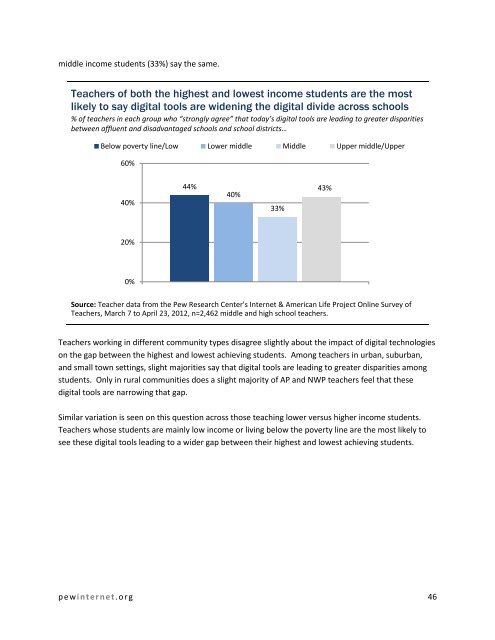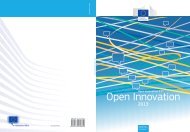How Teachers Are Using Technology at Home and in ... - Prisa Digital
How Teachers Are Using Technology at Home and in ... - Prisa Digital
How Teachers Are Using Technology at Home and in ... - Prisa Digital
You also want an ePaper? Increase the reach of your titles
YUMPU automatically turns print PDFs into web optimized ePapers that Google loves.
middle <strong>in</strong>come students (33%) say the same.<br />
<strong>Teachers</strong> of both the highest <strong>and</strong> lowest <strong>in</strong>come students are the most<br />
likely to say digital tools are widen<strong>in</strong>g the digital divide across schools<br />
% of teachers <strong>in</strong> each group who “strongly agree” th<strong>at</strong> today’s digital tools are lead<strong>in</strong>g to gre<strong>at</strong>er disparities<br />
between affluent <strong>and</strong> disadvantaged schools <strong>and</strong> school districts…<br />
Below poverty l<strong>in</strong>e/Low Lower middle Middle Upper middle/Upper<br />
60%<br />
40%<br />
20%<br />
0%<br />
44%<br />
40%<br />
Source: Teacher d<strong>at</strong>a from the Pew Research Center's Internet & American Life Project Onl<strong>in</strong>e Survey of<br />
<strong>Teachers</strong>, March 7 to April 23, 2012, n=2,462 middle <strong>and</strong> high school teachers.<br />
<strong>Teachers</strong> work<strong>in</strong>g <strong>in</strong> different community types disagree slightly about the impact of digital technologies<br />
on the gap between the highest <strong>and</strong> lowest achiev<strong>in</strong>g students. Among teachers <strong>in</strong> urban, suburban,<br />
<strong>and</strong> small town sett<strong>in</strong>gs, slight majorities say th<strong>at</strong> digital tools are lead<strong>in</strong>g to gre<strong>at</strong>er disparities among<br />
students. Only <strong>in</strong> rural communities does a slight majority of AP <strong>and</strong> NWP teachers feel th<strong>at</strong> these<br />
digital tools are narrow<strong>in</strong>g th<strong>at</strong> gap.<br />
Similar vari<strong>at</strong>ion is seen on this question across those teach<strong>in</strong>g lower versus higher <strong>in</strong>come students.<br />
<strong>Teachers</strong> whose students are ma<strong>in</strong>ly low <strong>in</strong>come or liv<strong>in</strong>g below the poverty l<strong>in</strong>e are the most likely to<br />
see these digital tools lead<strong>in</strong>g to a wider gap between their highest <strong>and</strong> lowest achiev<strong>in</strong>g students.<br />
p e w<strong>in</strong>ter n e t .o r g 46<br />
33%<br />
43%
















